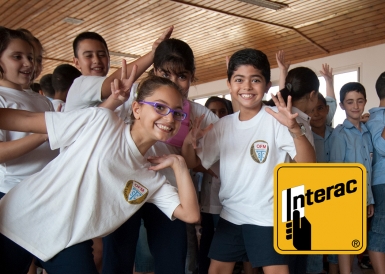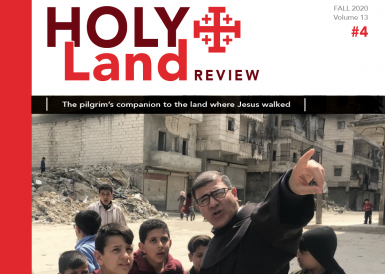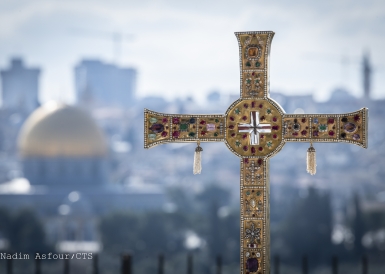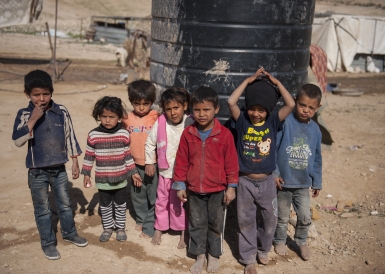
but is it a utopia?
A rare peace summit was held in Jerusalem last May. In a joint interview Terre Sainte Magazine sat down with three of its leading organizers: Mika Almog, May Pundak and Maya Savir. These women represent a new generation of activists determined to restore a political foundation for peace.
By Cécile Lemoine
What Does the Word “Peace” Mean in Israel Today?
May Pundak: Naivety.
Mika Almog: You can say that again! And that would be a generous reaction. Usually, “peace” is equated with betrayal. That’s the result of thirty years of politics rooted in hatred and dehumanization. When we were growing up, there was an actual peace process. Some opposed it, sure—but there was a real political will. We saw the Oslo Accords die with Prime Minister Yitzhak Rabin in 1995. Since then, the very idea of peace has been buried beneath talk of the status quo, ‘conflict management,’ and the belief that the Palestinians will eventually give up.
Maya Savir: October 7 was the consequence of the absence of peace. Peace remains the only way to prevent such a tragedy from happening again.
You are the original organisers of a coalition of 60 organizations that today embody the camp of peace. You have called it "It's time". Is there really still time?
Maya Savir: It is in times of war that we come closest to peace. Not during periods when the status quo is kept, when nothing moves. Disasters create opportunities. We have to seize them. This is the moment.
May Pundak: Let’s not forget that the foundations of the United Nations were laid in 1943, in the darkest years of World War II.
Maya Savir: Many voices, both among Israelis and Palestinians, say that it is too late; that we’re in the worst phase of the conflict. That it seems insoluble. Confidence is at an all-time low. But let's take a bit of distance. History has known other major conflicts that have been resolved: apartheid in South Africa, the genocide in Rwanda, the war in Ireland... Their story was just as complicated as ours. We can learn from these processes. One of the major obstacles to peace is the belief that the other side is not ready to make it. With this coalition, we want to show that there are partners, and that there is a way forward.
Mika Almog: We are facing a bloody, terrifying conflict. For the moment, all the opposition is doing is saying "no": "no" to war, "no" to the government that is forgetting about the hostages ... Much energy is directed against "what should not be", while it is now urgent to say what "should be", to present a vision, a plan for the future.
Your relatives negotiated the Oslo Accords in 1993. What lessons have you learned from this peace process, and what are you doing differently?
Mika Almog: We’ve learned a lot about the importance of building relationships between leaders. But we’ve also learned that groundwork is essential. Oslo moved too fast—public opinion wasn’t ready. That’s why today, our focus is on the groundwork, on preparing minds. My grandfather, Shimon Peres, didn’t always speak of peace. Early in his career, he was much more focused on Israel’s strength and its capacity for self-defense.
Maya Savir: Another lesson from Oslo is that we need to reverse the usual step-by-step approach. Every time a peace process begins to take shape, the extremes try to sabotage it. That’s why the key objectives must be secured at the very start. The ultimate goal—an independent Palestinian state—needs to be made concrete from the beginning. Another lesson, to be kept in mind, is that mutual recognition must be at the heart of the process. It has to be the starting point, because its psychological impact and its healing potential are enormous.
May Pundak: The Oslo Accords envisioned the creation of two independent states. But that solution no longer reflects today’s reality—people have changed, and so has the land. We need new ideas. One promising model is a federation. That’s what we’re working on at “A Land for All.” We often describe it as: “the two-state solution that could work.”

but it has the merit of existing and keeping the flame burning.
And how would it work?
May Pundak: There would be two sovereign states, based on the 1967 borders, to end the Occupation, create a shared homeland, and to end the conflict. Borders would be open, and the two states would create a joint framework with shared institutions. Palestinian refugees would return gradually. Jerusalem would be jointly administered, with recognition of its dual national identity ... The day the country is ready, we’ll have a pragmatic solution that both sides can live with.
Maya Savir: “A Land for All” is one of several civil society organizations using political imagination to craft innovative solutions. If you look at other resolved conflicts, civil society played a vital role in the years leading up to change. Their work helps prepare minds and hearts for what’s to come.
Does your coalition have political ambitions?
Mika Almog: Some of the 60 NGOs involved have their sights set on politics. But as a coalition, our goal is simply to lay the groundwork—to build a political base. To bring people together and show them they’re not alone.
Maya Savir: The idea is to be sufficiently large to have real influence. The centrist and left-wing parties have lost their courage. One of our aims, for example, is to pledge our votes to politicians who make resolving the conflict part of their platform. It’s a way to exert pressure. Before this disastrous government, we had four consecutive elections—and not one coalition offered a plan to address the conflict. That has to change.
May Pundak: To create real change, you need a vision—and you need to articulate that vision clearly: Where are we going? What are we trying to build? Israeli society hasn’t asked itself those questions in a long time. This coalition offers an alternative. We’re building hope—not blindly, but through action and reflection. The only way to believe that Israelis and Palestinians can work together is by actually doing it.
You’re three women. That’s a change from the usual peace processes led by men...
Maya Savir: This coalition began just over a year ago, in a room with ten women. Like much of Israeli civil society, it’s women who are the driving force behind the peace camp.
Mika Almog: In 2025, most decision-making rooms are dominated by men. Women remain a minority, even though they make up 50% of the population. Their voice is not taken into account. The real issue is equal representation.
May Pundak: Women bring a more holistic understanding of what security really means. For us, security isn’t about tanks; it’s about access to water, a light in a parking lot, a functioning healthcare and education system. Yes, this coalition is led by women, but more importantly, it’s the most inclusive coalition in the history of the peace camp. It brings together those who’ve long been excluded from the peace process—young people, Palestinian citizens of Israel, religious communities… That’s how change will happen. This is our conviction.
Maya Savir: Everyone needs to feel a sense of responsibility. Peace belongs to all of us.
Bio Express

who was also one of the Oslo negotiators.
She co-directs "One Earth for All", an
organization thatpromotes the idea
of a federation to resolve the conflict.

president Shimon Peres, a key figure in the 1993
Oslo Accords.The 49-year-old is a screenwriter
and content director for the "It's Time" coalition.

negotiator of the Oslo Accords.
At 51, she heads the Israeli branch of
a conflict resolution organization called
"Search for Common Ground".



